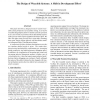Free Online Productivity Tools
i2Speak
i2Symbol
i2OCR
iTex2Img
iWeb2Print
iWeb2Shot
i2Type
iPdf2Split
iPdf2Merge
i2Bopomofo
i2Arabic
i2Style
i2Image
i2PDF
iLatex2Rtf
Sci2ools
DSN
2003
IEEE
2003
IEEE
The Design of Wearable Systems: A Shift in Development Effort
This paper describes a design process for custom wearable systems produced in an academic setting. A set of 245 wearable design defects from two distinct periods separated by six years in time is presented. These data identify aspects of the process which require significant developer effort. We show this effort using several views of the data, including time spent, design region affected, and distribution under an Orthogonal Defect Classification scheme. A comparison of defect attribute distributions across the two separate design periods is given. The results show that growing interoperability requirements are increasing design complexity, and inducing greater debugging effort. In addition, the combination of increasing pin counts and decreasing physical dimensions produce a higher rate of critical defects (i.e., those that require major physical modifications before debugging can continue). Finally, although the nature of the defects themselves has changed with time, the mechani...
Computer Networks | DSN 2003 | Greater Debugging Effort | Significant Developer Effort | Wearable Design Defects |
| Added | 04 Jul 2010 |
| Updated | 04 Jul 2010 |
| Type | Conference |
| Year | 2003 |
| Where | DSN |
| Authors | John G. Dorsey, Daniel P. Siewiorek |
Comments (0)

